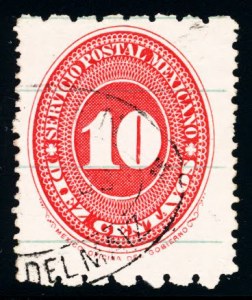
When it is found in family and friends, inconsistency can make make a person’s life miserable. But when found in our hobby, it adds spice and interest. Pictured above is one of my favorite stamps because of what it tells us about our hobby and the mercurialness of the editors of the Scott catalog. It is Scott #211 of Mexico and it catalogs about $200. It has the design, denomination and color of the 25c catalog value stamp of the previous issue set but the reason that it is valuable is that it has a compound perf of 12×6 (compound perfs are when the sides are perforated differently than the top and bottom. This was done for a variety of reasons, mainly in the late Nineteenth and early Twentieth Centuries, as an experiment, to find the optimal perforation type-one in which the sheets didn’t fall apart in the postal clerk’s drawer and which still separated easily. Needless to say, perf 12×6 was a short lived experiment. It separated too easily vertically and with too much difficulty horizontally).
Anyway, years ago, the editors of Scott decided that this stamp deserved its own major catalog number. Compound perfs are treated very differently by Scott from country to country. The Postage Dues of Romania have many remarkable compound perfs and Scott doesn’t list them at all. New South Wales has hundreds of compound perfs and Scott lists them as minor “a” numbers. In only a few countries (and even for most Mexican issues) and in only a few issues of those countries do such varieties as compound perfs get major catalog number status (and this is not just academic carping. The difference in how or whether an item is listed can mean lots of dollars to collectors and dealers). Indeed, Scott is in the process of changing its compound perf listings for US Washington-Franklins as we speak, adding to major number status stamps that for many years had been minor variety numbers and, before that, weren’t even listed at all. The Scott catalog has always been a work in progress, created by hundreds of editors and contributors over a period of nearly a century and a half. It is an extraordinary work but one that often lacks consistency between different countries and eras.

